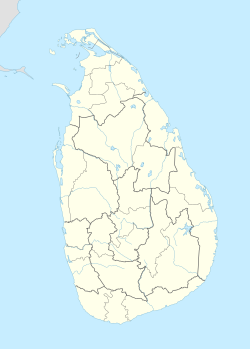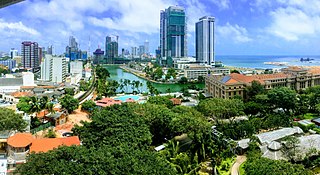
Colombo is the executive and judicial capital and largest city of Sri Lanka by population. According to the Brookings Institution, the Colombo metropolitan area has a population of 5.6 million, and 752,993 in the Municipality. It is the financial centre of the island and a tourist destination. It is located on the west coast of the island and adjacent to the Greater Colombo area which includes Sri Jayawardenepura Kotte, the legislative capital of Sri Lanka, and Dehiwala-Mount Lavinia. Colombo is often referred to as the capital since Sri Jayawardenepura Kotte is itself within the urban/suburban area of Colombo. It is also the administrative capital of the Western Province and the district capital of Colombo District. Colombo is a busy and vibrant city with a mixture of modern life, colonial buildings and monuments.
Sri Lanka Indo-Portuguese, Ceylonese Portuguese Creole or Sri Lankan Portuguese Creole (SLPC) is a language spoken in Sri Lanka. While the predominant languages of the island are Sinhala and Tamil, the interaction of the Portuguese and the Sri Lankans led to the evolution of a new language, Sri Lanka Portuguese Creole (SLPC), which flourished as a lingua franca on the island for over 350 years (16th to mid-19th centuries). SLPC continues to be spoken by an unknown number of Sri Lankans, estimated to be extremely small.
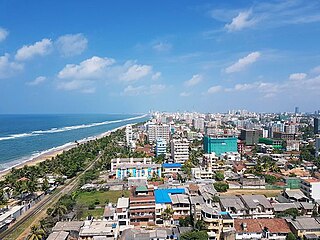
Dehiwala-Mount Lavinia, population 245,974 (2012), is a large municipality in Sri Lanka, covering 2,109 ha. It lies south of the Colombo Municipal Council area and is separated from it by the Dehiwala canal which forms the northern boundary of DMMC. Its southern limits lie in Borupana Road and the eastern boundary is Weras Ganga with its canal system and it includes some areas to its east. This town has experienced extensive population growth and rapid industrialisation and urbanisation in recent years. It is home to Sri Lanka's National Zoological Gardens, which remains one of Asia's largest. Colombo South Teaching Hospital, Kalubowila and Colombo Airport, Ratmalana are some important landmarks in this area. Dehiwela-Mount Lavinia and Sri Jayawardenapura Kotte being two large suburban centres of the city of Colombo function together as one large urban agglomeration in the Region. The overspill from the City in residential and commercial uses of land has rapidly urbanised these suburban centres. Dehiwela-Mount Lavinia and Sri Jayawardenpaura along with Colombo Municipal Council form the most urbanised part of the core area of the Colombo Metropolitan Region. Dehiwala and Mount Lavinia lie along the Galle Road artery, which runs along the coast to the south of the country.
Moratuwa is a large municipality in Sri Lanka, on the southwestern coast of Sri Lanka, near Dehiwala-Mount Lavinia. It is situated on the Galle–Colombo main highway, 18 km (11 mi) south of the centre of Colombo. Moratuwa is surrounded on three sides by water, except in the north of the city, by the Indian Ocean on the west, the Lake Bolgoda on the east and the Moratu river on the south. According to the 2012 census, the suburb had a population of 168,280.

Gampaha is an urban city in Gampaha District, Western Province, Sri Lanka. It is situated to the north-east of the capital Colombo. It is the sixth largest urban area in Western Province, after Colombo, Negombo, Kalutara, Panadura and Avissawella. Gampaha is also the second largest municipal centre in Gampaha district, after Negombo. Gampaha has a land area of 25.8 ha and is home to the offices of 75 government institutions.

Joseph Vaz, CO was an Oratorian priest and missionary in Sri Lanka (Ceylon). Originally from Sancoale in Portuguese India, Vaz arrived in Ceylon during the Dutch occupation, a time when the Dutch had banned Catholicism in Ceylon and imposed Calvinism as the official religion after taking control from the Portuguese Empire.

Negombo is a major city in Sri Lanka, situated on the west coast and at the mouth of the Negombo Lagoon, in the Western Province, 38 km (24 mi) from Colombo via the Colombo–Katunayake Expressway and the nearest major city from the Bandaranaike International Airport.
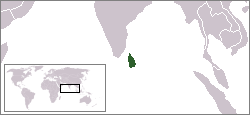
Sri Lankan place name etymology is characterized by the linguistic and ethnic diversity of the island of Sri Lanka through the ages and the position of the country in the centre of ancient and medieval sea trade routes. While typical Sri Lankan placenames of Sinhalese origin vastly dominate, toponyms which stem from Tamil, Dutch, English, Portuguese and Arabic also exist. In the past, the many composite or hybrid place names and the juxtaposition of Sinhala and Tamil placenames reflected the coexistence of people of both language groups. Today, however, toponyms and their etymologies are a source of heated political debate in the country as part of the political struggles between the majority Sinhalese and minority Sri Lankan Tamils.

Christianity is a minority religion in Sri Lanka. It was introduced to the island in first century. Traditionally, after Thomas the Apostle's visit in Kerala in AD 52, Christianity is said to have been introduced to Sri Lanka because of its close geographical and commercial ties.
Kalutara or Kalutota is a major city in Kalutara District, Western Province, Sri Lanka. It is also the administrative capital of Kalutara District. It is located approximately 43 km (27 mi) south of the capital Colombo. The city holds a unique position for one of the four major rivers in Sri Lanka, the Kalu Ganga, which joins the sea at the centre of the city. Kaluthara is known for making rope, baskets, and other articles from the fibre of the coconut palm. The area also produces the Mangosteens, a fruit introduced from Malaysia in the 19th century.
Wattala is a large suburb of Gampaha district, in Western Province, Sri Lanka, situated around 9 km from Colombo city centre. This suburb is situated on A3 highway from Colombo to Negombo. Around Wattala, there are many villages and towns.

Kala Wewa, built by the King Datusena in 460 CE, is a reservoir complex consisting of two reservoirs, Kala Wewa and Balalu Wewa. It has the capacity to store 123 million cubic meters of water. This reservoir complex has facilitated with a stone made spillway and three main sluices. From the central major sluice, a 40 feet wide central conveys water to feed thousands of acres of paddy lands and ends at the historical capital Anuradhapura city tank Tissa Wewa meandering over 87 km (54 mi) at a slope of 6 inches per mile and is another wonder of primeval hydraulic engineering facility in ancient Ceylon.
Seeduwa is a suburb of Negombo, in Katana Divisional Secretariat, Western Province of Sri Lanka. It is located on the A03 road between Colombo and Negombo.
Kandana is a suburb of Gampaha in Western Province, Sri Lanka, 19 km (12 mi) north of the Colombo city centre. Due to the proximity to Negombo as well as the Bandaranaike International Airport, the suburb is a popular residential area. The neighboring suburbs are Ja-Ela, Ragama, Peralanda and Wattala.

Mannar District is one of the 25 districts of Sri Lanka, the second level administrative division of the country. The district is administered by a District Secretariat headed by a District Secretary appointed by the central government of Sri Lanka. The capital of the district is Mannar, which is located on Mannar Island.
Dandugama is a village in Sri Lanka. It is own for Ja-Ela polling division at Gampaha District at Western Province, Sri Lanka.
Wattala Divisional Secretariat is a Divisional Secretariat of Gampaha District, of Western Province, Sri Lanka.
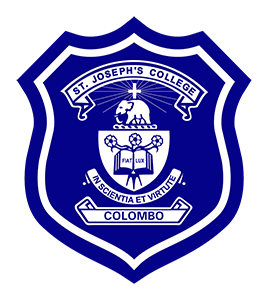
St. Joseph's College, Wattala also known as "St. Joseph's College Colombo 10 - Wattala Branch" was formerly known as St. Joseph's College, Enderamulla. It is a Catholic private school situated in the suburbs of Colombo. It is a selective entry Catholic school commenced on 10 January 1996 under the guidance of Rev. Dr. Stanley Abeysekera. The College enrolls over 1,400 students with a staff of over 85.

St. Sebastian's Church, Enderamulla is a Roman Catholic church in the Archdiocese of Colombo, Sri Lanka. It is located in Enderamulla, Wattala. The church was established in 1891. After being a co‑parish with Dalugama (1879–1903) and Kirimetiyagara (1903–1934), it was declared as an independent parish in 1934.

St. Anne's Church, Wattala (Sinhala: සා. ආනා දේවස්ථානය, වත්තල is a Roman Catholic church located in Wattala, Gampaha District, Sri Lanka. It was established in 1872 as another Church of the Archdiocese of Colombo. The church is dedicated to Saint Anne.
